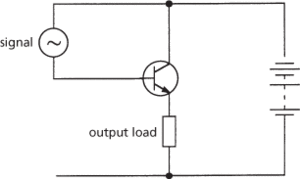An amplifying circuit using a bipolar junction transistor with a common-collector connection. The output is taken from the emitter.
An amplifier that consists of a bipolar junction transistor with common-collector connection, the output being taken from the emitter (see diagram). The transistor is suitably biased so that it is nonsaturated and conducting. The emitter voltage thus has a constant value relative to the base at all times, and the emitter follows the signal applied to the base. The voltage gain of the amplifier is therefore nearly unity but the current gain is high. The amplifier is often used as a buffer and is characterized by a high input impedance and low output impedance.
The FET analogue is the source follower and the thermionic-valve analogue is the cathode follower, although neither of these is as efficient a unity-gain buffer amplifier as the emitter follower, the voltage gain, particularly of the source follower, being further from unity.

Simple emitter follower
- VOIP
- VoIP
- Volans
- volatile
- volatile memory
- volatility
- volcanic-arc zone
- volcanic ash
- volcanic bomb
- volcanic centres
- volcanic conduit
- volcanic cone
- Volcanic Constructs
- volcanic dome
- volcanic dust
- volcanic-exhalative processes
- Volcanic Explosivity Index
- volcanic haze
- volcanicity
- volcaniclastic
- volcanic neck
- volcanic pile
- Volcanic Plains
- volcanic plug
- Volcanic units